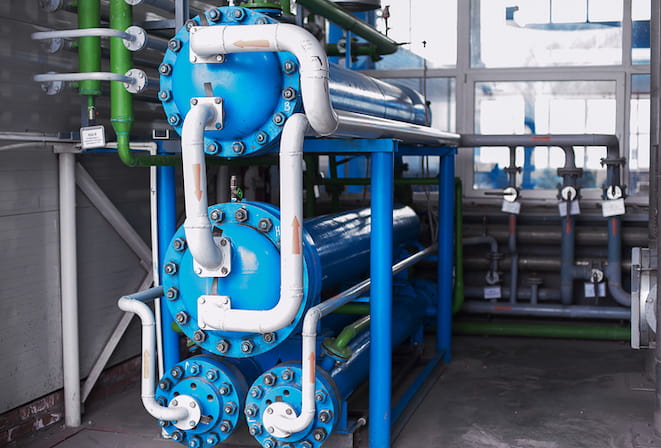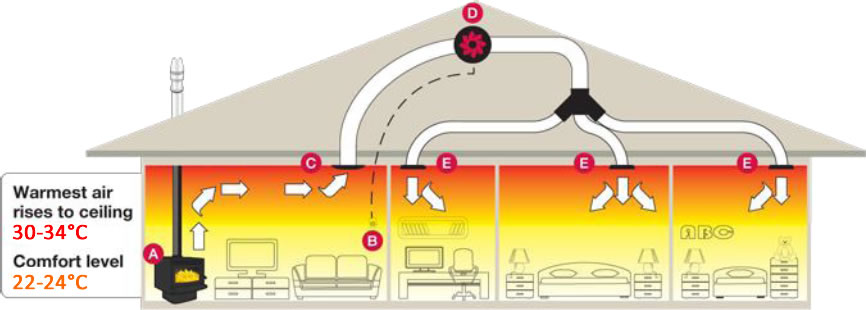DVS Heat Transfer Systems: The Future of Energy-Efficient Industrial Heating Solutions
Wiki Article
The Duty of Heat Transfer Equipments in Sustainable Power Solutions for the Future
Heat transfer systems are important in the mission for lasting energy options. They maximize thermal power monitoring, enhancing the efficiency of sustainable innovations. By utilizing systems like radiation, transmission, and convection, these systems decrease power losses. Their duty in solar thermal and geothermal applications is specifically substantial. As technologies arise, the possibility for more innovations elevates important inquiries concerning future power methods. What advancements will shape the landscape of sustainable energy?Recognizing Heat Transfer Solutions

The Value of Thermal Power Administration
Efficient thermal energy management is important for making best use of power performance and decreasing waste in numerous systems. By controling temperature and enhancing Heat transfer procedures, companies can markedly lower power usage and operational costs. Reliable administration involves the implementation of advanced modern technologies and methods that keep an eye on and control thermal problems within systems, making sure that energy resources are used efficiently. Additionally, appropriate thermal energy monitoring contributes to reducing greenhouse gas discharges, aligning with international sustainability goals. It additionally enhances system integrity and performance, bring about improved item quality and longer devices lifespan. Eventually, focusing on thermal energy administration is a vital step in the direction of creating a lot more lasting energy options and fostering an accountable strategy to energy usage in commercial and domestic contexts.Applications of Heat Transfer in Renewable Resource
While numerous renewable resource resources assure sustainability, the efficient application of Heat transfer plays an essential function in their performance. In wind power systems, Heat transfer is utilized for wind turbine part air conditioning, enhancing performance and durability. Geothermal power counts on effective Heat exchange between the planet's subsurface and the liquid flowing in the system, making best use of energy extraction. Biomass energy processes likewise profit from Heat transfer, as it assists in transforming natural materials into usable fuel through pyrolysis and gasification. Additionally, in hydropower, preserving suitable temperature levels in storage tanks can boost power result. Each of these applications shows the essential importance of Heat transfer systems in boosting eco-friendly power modern technologies, inevitably adding to an extra lasting power future.Enhancing Solar Thermal Power Effectiveness
As solar thermal power systems remain to progress, improving their effectiveness has come to be vital for taking full advantage of energy outcome. Advances in Heat transfer technologies, such as enhanced thermal storage products and cutting-edge Heat exchangers, play a considerable role in enhancing efficiency. By making use of sophisticated materials that have superior thermal conductivity, systems can capture and move Heat extra properly. Additionally, integrating radar that adhere to the sunlight's path warranties that enthusiasts get perfect solar exposure throughout the day. Making use of nanotechnology in solar absorbers can even more increase power absorption rates. Furthermore, including automatic control systems aids handle and regulate temperature levels energy circulation effectively, bring about minimized losses and improved total system efficiency. These enhancements lead the method for even more lasting solar thermal energy remedies in the future.Geothermal Heating: A Lasting Service
Geothermal heating provides a practical option for sustainable energy, providing substantial environmental advantages with reduced greenhouse gas discharges. Its efficiency and cost-effectiveness make it an eye-catching option to traditional furnace. Difficulties associated to execution has to be resolved to optimize its potential effect.Environmental Advantages of Geothermal
Standard home heating methods add considerably to greenhouse gas emissions, geothermal home heating offers a compelling alternative that reduces environmental influence. By harnessing the Planet's inner Heat, geothermal systems utilize a renewable resource resource, substantially lowering dependence on fossil fuels. This method creates very little carbon discharges, making it a cleaner option for industrial and domestic home heating. Furthermore, geothermal systems promote power performance, as they need less power compared to standard heating systems. DVS Heat Transfer Systems. The utilization of geothermal power also aids in minimizing air pollution, boosting regional air quality and public wellness. As a sustainable solution, geothermal home heating supports environment change reduction efforts, placing itself as a crucial element in the change in the direction of a greener futureEfficiency and Cost-Effectiveness
Just how does geothermal heating measure up in regards to effectiveness and cost-effectiveness compared to typical heater? Geothermal heating shows superior performance, usually accomplishing a coefficient of efficiency (POLICE) of 3 to 5, implying it produces 3 to 5 systems of Heat for every device of electrical power consumed. This performance translates right into lower operating expenses, specifically in regions with steady geothermal resources. Preliminary installation expenses can be more than traditional systems; nonetheless, long-lasting financial savings on energy costs and reduced upkeep expenses can balance out these upfront financial investments. Additionally, numerous federal governments incentivize geothermal systems through rebates and tax debts, enhancing their cost-effectiveness. On the whole, geothermal heating emerges as a lasting and economically practical option to even more standard home heating remedies.Execution Obstacles and Solutions
Numerous challenges can impede the widespread implementation of geothermal furnace, despite their clear advantages as a sustainable energy solution. High initial installment costs often deter investors and property owners, making financing a significant obstacle. In addition, the geographical constraints of ideal geothermal websites limit availability in specific regions. Local regulations and permitting procedures can additionally make complex job development, leading to delays. Public recognition and understanding of geothermal systems stay low, hindering approval. To resolve these difficulties, targeted education campaigns can boost public knowledge, while federal government motivations can ease monetary concerns. Collaborating with neighborhood authorities to improve regulations might assist in smoother project authorizations, eventually promoting the fostering of geothermal heating as a feasible, lasting energy alternative.Technologies in Heat Transfer Technologies
Technologies in Heat transfer technologies play a crucial role in boosting energy performance and sustainability. Advanced Heat exchangers and stage adjustment materials go to the forefront of these growths, using significant enhancements in thermal monitoring. These technologies not only optimize energy use but also add to reducing ecological effect in different applications.Advanced Heat Exchangers
Advanced Heat exchangers play an essential duty in enhancing energy performance throughout various applications in sustainable energy options. These tools facilitate the transfer of Heat between 2 or even more liquids, noticeably lowering energy usage in procedures such as commercial home heating, cooling, and power generation. Developments in materials and style, such as making use of nanofluids and portable arrangements, have resulted in improved thermal performance and decreased size requirements. Furthermore, developments in digital surveillance and control systems permit optimized operation, further enhancing efficiency. By reducing waste Heat and making best use of power recuperation, progressed Heat exchangers add to decrease carbon impacts and sustain the shift toward environmentally friendly technologies. Their continued growth is essential for attaining international energy sustainability objectives.
Stage Adjustment Materials
The integration of phase change products (PCMs) into Heat transfer technologies represents a significant development in power monitoring and performance. PCMs soak up and release thermal energy throughout their phase changes, enabling reliable temperature level law in structure products and energy systems. By storing excess Heat throughout height durations and launching it when need boosts, PCMs add to fill changing and energy preservation - DVS Heat Transfer Systems. This capacity improves the performance of renewable power systems, especially in solar thermal applications. Additionally, PCMs can boost the thermal convenience of interior settings, reducing reliance on traditional DVS Heat Transfer Systems heating and cooling down approaches. As innovations in PCM solutions continue to emerge, their duty in sustainable power services is positioned to grow, using promising methods for future research and application
Future Potential Customers for Heat Transfer in Sustainable Energy
As the demand for lasting power options continues to rise, the role of Heat transfer systems is coming to be significantly essential in forming future modern technologies. Technologies in products and styles are anticipated to improve efficiency in Heat transfer, lowering power losses in different applications. The integration of advanced thermal storage space systems, such as phase modification materials and thermochemical storage space, will make it possible for much better management of power resources. Research right into nanofluids and biomimetic Heat exchangers might additionally maximize thermal efficiency. Additionally, the fostering of wise technologies will certainly permit real-time monitoring and flexible control of Heat transfer procedures. These developments are positioned to significantly add to the general effectiveness and sustainability of power systems, leading the way for a more energy-efficient future.Regularly Asked Inquiries
Exactly How Can People Execute Heat Transfer Systems in the house?

Individuals can carry out Heat transfer systems at home by setting up energy-efficient appliances, using radiant heat, and maximizing insulation. These steps boost energy effectiveness, reduce expenses, and advertise sustainable methods in household atmospheres.

What Are the Costs Related To Mounting Heat Transfer Solutions?
The costs linked with mounting Heat transfer systems vary widely, usually incorporating tools, setup labor, and maintenance. Variables such as system kind, home size, and neighborhood guidelines significantly influence the total expenditure entailed.Are There Government Rewards for Heat Transfer System Installations?
Federal government rewards for Heat transfer system setups vary by area and can include tax obligation refunds, gives, and credit histories. These financial advantages intend to encourage adoption, inevitably promoting energy effectiveness and lowering environmental effect within areas.How Do Heat Transfer Equipments Impact Energy Expenses?
Heat transfer systems notably influence power costs by optimizing energy effectiveness. By improving the transfer of Heat, these systems decrease power intake, leading to lower energy prices and producing an extra lasting method to energy administration.What Upkeep Is Required for Heat Transfer Systems?
Upkeep for Heat transfer systems consists of normal evaluations, cleansing of parts, examining liquid degrees, ensuring appropriate insulation, and replacing used components. These jobs aid keep efficiency, protect against break downs, and extend the system's functional life-span.These systems facilitate the movement of thermal energy from one medium to another, allowing the transfer of Heat for home heating, energy, or cooling generation objectives. Geothermal energy counts on effective Heat exchange in between the planet's subsurface and the fluid distributing in the system, making best use of power removal. Furthermore, geothermal systems promote energy performance, as they call for much less energy compared to standard home heating systems. Advanced Heat exchangers play a vital role in enhancing power effectiveness across various applications in lasting energy solutions. Heat transfer systems significantly influence power expenses by optimizing energy performance.
Report this wiki page